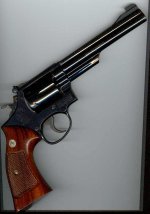You are using an out of date browser. It may not display this or other websites correctly.
You should upgrade or use an alternative browser.
You should upgrade or use an alternative browser.
6" .38 Special K-frame: Are they uncommon?
- Thread starter DMK
- Start date
Dave Markowitz
New member
Not all that uncommon, but perhaps not as popular as they used to be. Here's my Model 14.


Johnny Guest
Moderator in Memoriam
They used to be very popular - - -
In the days of exposed carry, five- and six-inch barrel revolvers were pretty popular. The longer sight radius made 'em easier to shoot well, and the longish barrel developed significantly more velocity with the older style powders, both black and smokeless. Also, a great many police issue revolvers were long barrel types.
As styles changed, the four-inch became THE service revolver for non-military law enforcement. There were probably more four-inch S&W Military & Police and Colt Official Police four-inch revolvers manufactured than all other revolvers put together.
By fitting the same type stocks to a six-inch revolver, a police officer could shoot a match revolver which felt nearly the same as his duty sidearm.
NRA bullseye match rules specified maximum sight radius, based upon the six-inch revolver with the rear sight mounted on the far rear of the frame. This was the basis of the S&W match series, K22, K32, and K38 - - Using the same size frame and varying width barrel ribs, the shooter could have a battery for the whole spectrum of matches which felt the same and were of about the same weight. With the decline of revolvers in bullseye shooting, one big market for the six-inch K-frame went away.
There was a similar popularity and decline in the PPC match game.
Back to service handguns: With the coming of the .357 magnum, officers could carry a shorter barrel revolver which was far more comfortable in a car seat than a six-inch .38, and still was more powerful.
An old six-inch .38 revolver is still an item of classic beauty, but is simply not as practical as it once was. For similar size and weight, one can have the versatility of a .357. I've owned two Colt Officers Model Match .38s, which shot very well indeed. Wish I still had one of 'em. And I know of at least one Officers Model Special that has taken a couple of head of game.
And I know of at least one Officers Model Special that has taken a couple of head of game.
Anyway, as popular as the six-inch .38s used to be, there have been few made in the past 20 or 30 years. The extant examples ore often cherished family keepsakes, or have migrated into collections. The ones that infrequently surface are more often seen in pawnshops than in gun stores. Am I right, Tamara?
Best,
Johnny
In the days of exposed carry, five- and six-inch barrel revolvers were pretty popular. The longer sight radius made 'em easier to shoot well, and the longish barrel developed significantly more velocity with the older style powders, both black and smokeless. Also, a great many police issue revolvers were long barrel types.
As styles changed, the four-inch became THE service revolver for non-military law enforcement. There were probably more four-inch S&W Military & Police and Colt Official Police four-inch revolvers manufactured than all other revolvers put together.
By fitting the same type stocks to a six-inch revolver, a police officer could shoot a match revolver which felt nearly the same as his duty sidearm.
NRA bullseye match rules specified maximum sight radius, based upon the six-inch revolver with the rear sight mounted on the far rear of the frame. This was the basis of the S&W match series, K22, K32, and K38 - - Using the same size frame and varying width barrel ribs, the shooter could have a battery for the whole spectrum of matches which felt the same and were of about the same weight. With the decline of revolvers in bullseye shooting, one big market for the six-inch K-frame went away.
There was a similar popularity and decline in the PPC match game.
Back to service handguns: With the coming of the .357 magnum, officers could carry a shorter barrel revolver which was far more comfortable in a car seat than a six-inch .38, and still was more powerful.
An old six-inch .38 revolver is still an item of classic beauty, but is simply not as practical as it once was. For similar size and weight, one can have the versatility of a .357. I've owned two Colt Officers Model Match .38s, which shot very well indeed. Wish I still had one of 'em.
Anyway, as popular as the six-inch .38s used to be, there have been few made in the past 20 or 30 years. The extant examples ore often cherished family keepsakes, or have migrated into collections. The ones that infrequently surface are more often seen in pawnshops than in gun stores. Am I right, Tamara?
Best,
Johnny
Johnny Guest,
FWIW, that's the only Model 14 that I can remember passing through my logbook in the last ten years of working in gun shops. Take that for what it's worth...
Am I right, Tamara?
FWIW, that's the only Model 14 that I can remember passing through my logbook in the last ten years of working in gun shops. Take that for what it's worth...




